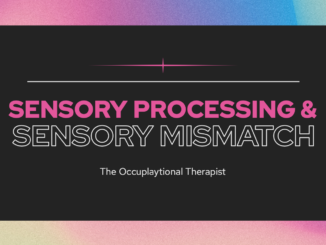Did you know that yelling is, from a sensory perspective, a very regulating thing to do?
That might sound weird and it might make your brain jump to conclusions that aren’t the same as exactly what I’m saying. But think about it for a moment, from a mental perspective of thinking of the mechanics of the body.
Yelling requires you to take a deep breath, and usually to continue deep breathing as well. Yelling produces a sound which is entirely within your control, and usually drowns out many, if not all, of the surrounding sounds in the environment for you (the yeller). Yelling often goes along with opening your jaw to a degree to where you can feel a “stretch” as you forcefully yell whatever it is that you’re yelling.
Yelling is a powerful, energetic, emotional release.
Also, *of course*, you don’t need me to tell you, that yelling AT somebody in a negative or angry way can be harmful to your relationship with that person and to the emotions of both of you.
Recently I was in an IEP meeting for a child who was having a really hard time at school. Among other struggles, when things began to get hard for them, they would simply begin screaming and not stop…not stop…not stop. Other people would have to leave the room, or the child would have to be escorted elsewhere because they would just yell, and yell, and yell. It might be words or it might be a sustained yelled note.
Among other suggestions personal to this child and the specific struggles they were having, I offered all of the above information as a reframe to the team.
-That I knew for a fact this child was often overwhelmed by sounds in the environment around them, so yelling could be meeting that need.
-That I knew for a fact that this child was perceiving adults beginning to “correct” them when things started to go badly as a threat to their safety, so yelling blocked out that threat.
-That adults around this child were often encouraging them to participate in everybody’s favorite token “self-regulation tool” — taking deep breaths — and that this child was, in fact, doing exactly that (in a way)! Not that I thought the child was doing it “wrong on purpose” or anything like that, but just pointing out how they were, in fact, taking deep breaths.
I have talked before about how making small noises, such as humming or singing, may be a strategy that children use instinctually in order to block out distracting sounds in the environment. It seems counter-intuitive to people because they think “but they’re just making there be *more* noise in the environment!” but it’s not actually about the total decibels in the room or whatever, it’s about the child having control over what they hear and producing a sound that is less personally bothersome to them than the triggering noise.
Yelling can be that way too, with the added element of being powerful and trying to grab back at control in a situation where the person feels powerless.
All of this may apply to adults who struggle with yelling, too.
Adults who struggle with yelling when they’re in a challenging situation could be struggling with one or many or all of these things:
-Meeting a sensory need to cover up the noise in the environment — e.g., kids are getting too loud so you suddenly snap and yell at them to stop. Your yell covers up the noise briefly and your body feels like that will help, even if your logical part of your brain knows it won’t.
-Meeting a sensory need to have strong, self-regulating proprioceptive (deep body pressure) sensory input through the throat, jaw, tongue, lungs, and abdomen. Deep body pressure is one of the fastest and most dependable ways to self-regulate, so your body gets pushed to a point where a switch flips and it goes, “I need a burst of regulating sensory input NOW!”
-Meeting a self-regulation need to take a deep breath and soothe a nervous system that is crying out for a deep breath — but coupled with the triggers in the environment, the person yelled in addition to the breath instead of just taking a breath.
-Meeting an anxiety-based need to assure themself that they do have “control” over the situation, or that they have power and are not in fact powerless — yelling is big and powerful and feels like it’ll be reassuring to the body to do such a big, powerful move (even if your logic brain knows it won’t help anything.)
-Meeting an anxiety-based need to suddenly do “something” rather than do “nothing” — getting pushed past the point where you feel like you must take action NOW, so the action comes out of you quick and strong rather than being a measured action.
-Meeting a need for conflict resolution but only knowing how to copy the patterns that were modelled for them — they never saw anyone or learned any way to deal with conflict other than escalating to yelling.
-Meeting a need for conflict resolution and doing their absolute best to be an improvement on the patterns that were modelled for them that were even *more* harmful than yelling, but this is as best as they know how to do it.
There could be other factors at play too — this list isn’t intended to be exhaustive so much as to bring awareness to smaller building-blocks that could be going on behind the scenes, because once we have language to describe the smaller chunks of what we’re experiencing, then we can start to work toward solutions, because we can describe what the need is and look for alternate ways to meet it rather than just scolding ourselves for the behavior. (just like we want to do with our kids — find an alternate way to meet the need!)
Solutions (for adults OR kids) might look like:
-In-the-moment strategy: Take a deep breath without any yell attached
-Preemptive strategy: Set a specific triggering feeling, event, or time to take a deep breath without any yell attached (i.e.: “I will set a 5 minute timer on this activity and then pause to check in with my body and how I feel about this and take 3 deep breaths”; “I will roughhouse with my kids for the duration of this 10 minute timer and then I will pause to see how we’re all doing and take a deep breath”)
-Preemptive strategy: Sing out loud, maybe even REALLY loud or maybe with a yelly, shouty, metal or punk or hard rock song, at a set time every day to give your body that heavy proprioceptive feedback
-In-the-moment strategy: Sing as a coping mechanism to deal with a situation that is escalating but not out of control yet, either to a made-up tune or by swapping the words out for an existing song. Maybe singing “Time for diinnnerrrrr!” to the tune that those words are sung in We Don’t Talk About Bruno helps you stop from yelling at your kids to stop what they’re doing and get over here already.
-Preemptive strategy: Rehearse common-to-you or common-to-your-family conflicts and role play what you will do in them instead. Could be out loud, could be with a trusted person, could be by yourself in the shower or in the car or whatever.
-Preemptive strategy: Take notice of what events are triggering yelling. Write them down in a phone note or a journal if you want to, or just pay attention to what repeated patterns around yelling are taking place. Use that to make a strategy that will help you avoid being put in the situation in the first place, or take mitigating steps to make the situation less bad.
-Preemptive strategy: Carry headphones or earplugs to drown out overwhelming noise or at least tone it down a little
-Preemptive strategy: Play music, white noise, or another noise that you like in situations that have a tendency to escalate to overwhelming noise, because having the familiar, predictable, “good” noise can help your brain seek it out in the chaos and recenter.
-Preemptive strategy: Print out, or write down, mantras or quotes or words that help encourage you in regards to anxiety about “doing nothing” or common-to-you parenting or situational triggers.
-Preemptive and in-the-moment strategy: Find something very small, simple, and concrete that you can do when you are feeling “out of control” that you can quickly complete and feel like you have controlled/accomplished something. For example, a small fidget that you can take apart and put back together, a simple puzzle game on your phone that you can usually solve with success, or a mental game such as “name one thing around you that is each color of the rainbow”. Determine this strategy ahead of time, and when you get to a point where you’re feeling like you’re quickly escalating to feeling powerless or out of control BUT your logic brain knows the situation is actually OK, distract the “oh no I’m powerless” side of your brain by empowering it by completing the small thing you determined ahead of time.
-Preemptive and in-the-moment strategy: Find a shocking, alerting sensory strategy that you (or the child) do not find unpleasant — not that hurts you in any way or you want to avoid — just something that is very alerting to the senses. Some examples of this could be tasting a strong mint flavor, spicy flavor (i.e. cinnamon), or sour flavor (i.e. candies); running cold water over your hands; eating something cold like an ice cube; jumping up and down with both feet flat; making a spinning, rocking, or other rapid movement motion (e.g., lying down on the floor) in a safe way. Pick one strategy and start with that, but if it helps eventually to have more than one, that is great! When you’re in a moment where your body starts to feel like it might get out of control, doing a “shocking” sensory input can sometimes jolt the system out of the old pattern that it was going to repeat again. Then, that jolt of alertness to your brain can help you buy a few seconds or minutes to make a decision about what to do with your logic brain instead of by repeating old patterns. I can’t say this too many times: DO NOT do this in a way that hurts yourself or a child or that you or the child find unpleasant! If anything, it should be an *enjoyable* alerting experience.
Just like my list of reasons, my list of suggested solutions is far from exhaustive because I am not in your brain and I can’t tell you exactly what will work for you (or for a child you work with). But hopefully this is at least reasonably comprehensive in regards to beginning to build new pathways and new strategies when all you want to do is yell.



